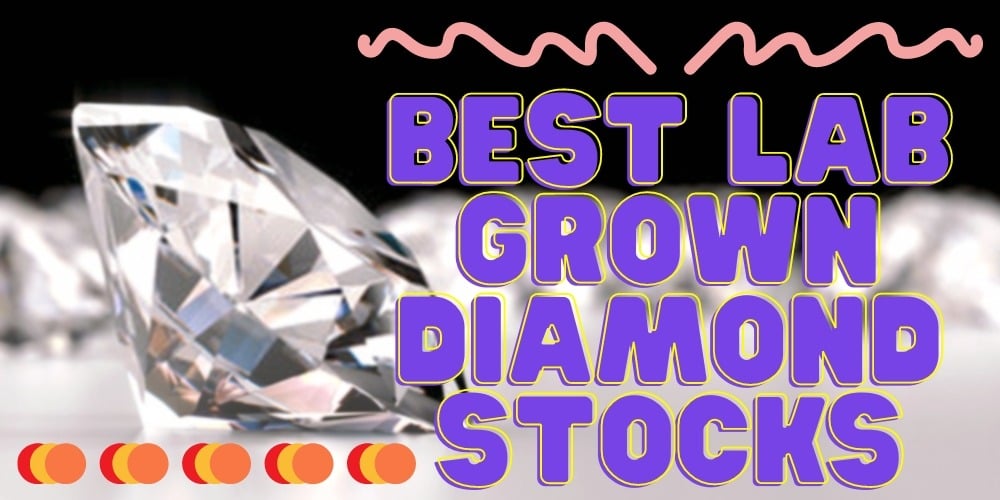The diamond industry is undergoing a transformation as lab-grown diamonds gain popularity for their ethical and sustainable qualities.
These diamonds, produced in controlled environments, offer a more affordable alternative to traditionally mined diamonds, while maintaining the same physical and chemical properties.
As consumer demand for sustainable luxury goods rises, lab-grown diamond companies are positioned to benefit from this trend.
This article explores some of the top lab-grown diamond stocks that could present exciting investment opportunities.
We’ll also consider key factors when evaluating diamond stocks, such as scalability, market position, and sustainability initiatives.
Best Lab-Grown Diamond Stocks To Start Tracking
LVMH Moët Hennessy – Louis Vuitton, Société Européenne (OTCMKTS: LVMHF)
LVMH, a global leader in luxury goods, entered the lab-grown diamond market by investing in Lusix, an Israeli lab-grown diamond manufacturer, and acquiring a minority share of the company.
LVMH’s involvement is notable, given that many of its brands, including Tiffany & Co. and Bulgari, have traditionally favored natural diamonds.
However, this investment signals the company’s acknowledgment of growing consumer interest in ethical and sustainable diamonds.
Lusix stands out as the world’s first lab-grown diamond producer powered by solar energy, aligning with sustainability trends.
As a diversified luxury goods conglomerate, LVMH’s investment portfolio includes high-end fashion, watches, and jewelry, making it a dominant player in the diamond jewelry sector.
Although not a pure-play lab-grown diamond stock, LVMH’s involvement in diamonds produced in labs could position it to benefit from the industry’s growth.
This diversification, combined with its extensive market reach, could make it an attractive option for long-term investors interested in both the luxury and lab-grown diamond markets.

Adamas One Corp. (NASDAQ: JEWL)
Adamas One Corp. is a pioneering lab-grown diamond company that specializes in producing both industrial-grade and jewelry-quality diamonds.
Adamas employs a proprietary method called chemical vapor deposition (CVD) to create high-quality lab-grown diamonds.
This process allows for scalability, a key factor in the company’s growth potential as the lab-grown diamond market expands rapidly.
Adamas holds 36 patents related to its diamond production technology, making it an industry leader in innovation.
Despite its small market capitalization, Adamas offers significant growth opportunities.
As the demand for sustainable diamond producers increases, the company’s ability to quickly scale production could be a competitive advantage.
Adamas has focused on capturing a share of the growing lab-grown diamond market, which has become one of the fastest-growing segments in the luxury goods industry.
For investors looking for exposure to the artificial gemstones sector, Adamas One Corp. could be a high-risk, high-reward opportunity in a rapidly evolving market.

Signet Jewelers Limited (NYSE: SIG)
Signet Jewelers, the parent company of well-known brands like Zales, Kay Jewelers, Jared, and Piercing Pagoda, is a significant player in the diamond industry.
As the company evolves, it has embraced lab-grown diamonds as part of its product offerings, appealing to environmentally conscious consumers who seek sustainable diamond solutions.
Signet’s commitment to ethical sourcing is highlighted by the introduction of a Responsible Sourcing Protocol that ensures all synthetic diamonds meet international standards.
Signet’s sub-brands, such as Jared and Kay Jewelers, have further expanded into the lab-grown diamond market by offering innovative collections.
Jared, for example, introduced a full bridal collection featuring customizable lab-grown diamond engagement rings, while Kay Jewelers has also rolled out similar offerings.
This shift towards lab-grown diamonds has positioned Signet to attract a new generation of buyers looking for more eco-friendly and ethical alternatives to traditionally mined diamonds.
In terms of growth potential, Signet has seen remarkable market performance in recent years.
The company has demonstrated resilience through market fluctuations, with its stock rebounding significantly after earlier downturns.
By adapting to consumer trends and integrating lab-grown gemstones, Signet might continue to be a major player in both the traditional and lab-grown diamond sectors.
With its diversified portfolio and global presence, Signet is a brand to watch as the lab-grown diamond sector gains momentum.

Are Lab-Grown Diamond Stocks a Good Investment?
Understanding Lab-Grown Diamonds vs. Mined Diamonds
Lab-grown diamonds have gained traction in recent years due to their ethical production processes compared to classic mining methods.
Unlike diamond mining companies that rely on often unethical mining methods, lab-grown diamonds are created in a controlled environment using advanced techniques like chemical vapor deposition (CVD) and high-pressure, high-temperature (HPHT).
These artificially grown diamonds are physically indistinguishable products from natural rough diamonds, making them an appealing alternative in the luxury market.
Their demand is growing rapidly, not just for diamond jewelry but also in industrial applications.
Benefits and Risks of Investing in Lab-Grown Diamonds
Investing in lab-grown diamond stocks could offer significant growth opportunities as the diamond industry evolves.
As a sustainable diamond producer, the appeal of lab-grown diamonds lies in their lower production process costs and shorter supply chains compared to traditional mining diamonds.
However, market performance can fluctuate, particularly given competitive pressure from both traditional diamond mining corporations and other market segments.
Investors should weigh these factors alongside the risks involved with the stock’s volatility and the relatively short period of mainstream adoption.
Criteria for Selecting Lab-Grown Diamond Stocks
When evaluating lab-grown diamond stocks, consider the company’s production history, its role in synthesizing diamonds, and the market share it holds in the diamond business.
Companies that focus on scalability and have production expansion strategies are well-positioned to capture market share in the rapidly growing lab-grown diamond market.
It’s also worth investigating their partnerships in the jewelry industry and their ability to produce precious stones that meet luxury standards.
Risks and Strategies
Investors should be aware of the fierce competition between classic mining companies and lab-grown diamond manufacturers.
Some diamond mining companies are still strong players, but many could face financial struggles as the market shifts.
Cash burn and market fluctuations may also pose challenges for investors.
To mitigate risk, a balanced portfolio that includes both lab-grown diamond stocks and more traditional diamond stocks could offer stability.
Long-term investors should look for companies with strong financial performance and the ability to adapt to industry changes.
Where to Invest: Robinhood vs. Webull
For those looking to invest in lab-grown diamond stocks, platforms like Robinhood and Webull provide easy access to the stock market.
Robinhood is favored by beginner investors due to its user-friendly interface and commission-free trading, while Webull offers more advanced analytics tools, making it suitable for investors who prefer to conduct in-depth market research.
Both platforms offer access to securities mentioned in this article, allowing investors to easily buy shares in diamond stocks and other growth stocks.
FAQs
Who Is the Largest Producer of Lab-Grown Diamonds?
While Belgium is home to many lab-grown diamond producers, companies like De Beers’ Lightbox Jewelry and Diamond Foundry have made significant advancements in production scale.
Many diamond mining companies are expanding into synthetic production to stay competitive, but the largest producers vary by region and market segment.
Can You Invest in Lab-Grown Diamonds?
Yes, you can invest directly by purchasing diamonds or through lab-grown diamond stocks in companies involved in the gemstone production business.
These investments provide access to a segment that is disrupting traditional natural stones markets.
Are Lab-Grown Diamonds Sustainable?
Yes, lab-grown diamonds have a smaller environmental footprint compared to classic mining methods.
Their production avoids the harmful effects of mining diamonds and is seen as a sustainable diamond producer approach in the jewelry industry.
How Do Lab-Grown Diamonds Impact the Traditional Diamond Market?
The rise of lab-grown diamonds is disrupting classic mining companies, and some may even face bankruptcy as synthetic diamonds take market share.
The entire market is adapting, but most diamond mining companies must evolve to stay competitive.
How Are Lab-Grown Diamonds Made?
Lab-grown diamonds are produced in a controlled environment using techniques such as chemical vapor deposition (CVD) or high-pressure, high-temperature (HPHT), which replicate the natural conditions that form diamonds over millions of years.
How Do Lab-Grown Diamonds Affect Ethical Concerns in Mining?
Lab-grown diamonds alleviate many ethical concerns associated with traditional diamond mining, such as environmental destruction and human rights abuses tied to unethical mining methods.
They offer a more sustainable alternative to mining gemstones while meeting demand for precious stones.
Final Thoughts
Lab-grown diamonds are positioned to disrupt the diamond market, with strong potential for growth in both the luxury market and industrial applications.
While the market for artificial gems faces competitive pressure from traditional players, sustainable energy and ethical production methods make lab-grown diamonds an attractive option.
Investors should carefully evaluate the companies’ abilities to scale and adapt to changing market demands.


 Tags:
Tags:










